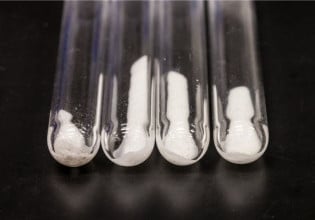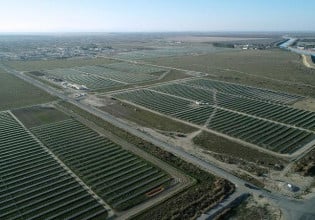Direct Current Generator Components
Learn about direct current generator components such as field windings, armature, commutators, brushes, and frames.
A generator (alternator) is a machine that uses electromagnetic induction to convert mechanical energy into electrical energy. A direct current (DC) generator works on the principle that a voltage is induced in a conductor coil when it is rotated in a magnetic field. The rate at which the coil rotates in the magnetic field determines the amount of voltage induced in the coil. When a conductor coil rotates at a constant rate in a magnetic field, the voltage induced in the coil is proportional to the rate of change of magnetic flux through the coil loops at any given instant of time. DC generators are made up of field windings, an armature, a commutator, brushes, and a frame (see Figure 1).

Figure 1. DC generators are made up of field windings, an armature, a commutator, brushes, and a frame.
Field Windings
Field windings are used in generators to produce the required magnetic field. The magnetic field can also be created by permanent magnets. Permanent magnets are used in magnetos, which are very small machines. A permanent magnet's magnetic lines of force decrease as it gets older, and its strength cannot be adjusted for control purposes. Electromagnets, which must be supplied with current, are used in the majority of generators. If the current for the field windings is provided by an external source (another generator or a battery), the generator is separately excited. The generator is termed as self-excited if it supplies its own current for the field windings. Generally, DC generators are self-excited.
Armature
A rotating armature and a stationary field (field windings) are always present in a DC generator. There are many coils in the rotating armature. Though increasing the number of coils lowers the output voltage ripples (pulsations), it is impossible to entirely eliminate them. The armature core is made of sheet-steel laminations that are electrically isolated from each other by coatings of varnish (see Figure 2).

Figure 2. The armature core is made of sheet-steel laminations that are electrically isolated from each other by coatings of varnish.
Eddy current is an unwanted current that is induced in a device's metal structure as a result of the rate of change in the induced magnetic field. Sheet-steel laminations are used to prevent eddy current. The sheet-steel laminations increase the overall resistance to eddy current flow and limit heat buildup. Experiments reveal that the eddy current power loss in a magnetic material is proportional to the square of the lamination thickness. Hence, reducing the lamination thickness by a factor of 2 reduces the eddy current power loss by a factor of 4.
The armature of high-power generators is often the stationary member (stator). The field then becomes the rotor of the generator. The reason for this design is that removing a very large current from the armature using brushes is not practical due to arcing. With the armature stationary, fixed wiring is used to remove the high current. Brushes are used to apply the current to the field windings since the current needed for the magnetic field is very small as compared to the current supplied by the generator.
Commutator
A commutator is a component of the armature that uses copper bars (commutator segments) to connect each armature coil to the brushes (see Figure 3). The end of a coil conductor is connected to a commutator segment. A voltage is induced in the conductor whenever the conductor cuts the magnetic lines of force of a magnetic field. Every half cycle, the connections to the brushes are reversed by the commutator segments. This ensures that the generator's output voltage has a constant polarity.

Figure 3. A commutator is a component of the armature that uses copper bars (commutator segments) to connect each armature coil to the brushes.
DC generators use wedge-shaped commutator segments. The number of commutator segments is determined by the voltage and the number of poles in the generator. Commutator segments are held together by V-rings. The voltage between commutator segments is limited to 15 V to prevent arcing. Commutator segments are composed of hard-drawn copper assembled on a cylinder. Each segment is insulated from the cylinder and other segments by pieces of mica.
Brushes
A brush is a sliding contact that rides against the slip rings and connects the armature to the outside circuit. Brushes are used to remove the electrical energy from the generator's commutator. Brushes are made of carbon or graphite materials and are usually easy to replace. A brush is held in a brush holder and is free to move up and down in the holder. The freedom allows the brush to follow irregularities in the surface of the commutator. Brush holders are mounted on the frame of the generator but are electrically insulated from it. A spring behind a brush forces it to make contact with the commutator. The spring pressure is usually adjustable. A pigtail connects a brush to the power supply. A pigtail is an extended, flexible connection or a braided copper conductor.
Brush material must have good conductivity and be soft enough not to damage the copper segments of the commutator. Brush material is composed of a mixture of carbon and graphite for high-voltage machines and of graphite and metallic powder for low-voltage machines. The graphite in the brushes provides lubrication. No other lubrication should be used since it may cause electrical problems and equipment damage.
Brushes can typically be worn down to a fraction of their original length before needing to be replaced. Because brushes wear down, constant pressure is applied with an adjustable tension spring so that the brushes can maintain contact with the commutator (see Figure 4). The pressure applied to the brushes is typically between 1.5 psi and 2 psi. Improper tension on the brush or misalignment with the axis of the commutator results in excessive arcing. Excessive arcing at the brushes greatly limits their life. Arcing at the brushes may be caused by improper spring tension; installation where contact with the full area of the commutator is not achieved; vibration or chatter during operation; dirty, worn, out-of-round, or loose commutator segments; defective solder connection between the coil and commutator segment; short-circuited armature windings; or an overloaded generator.

Figure 4. Because brushes wear down with use, constant pressure is applied with an adjustable tension spring so that the brushes can maintain contact with the commutator.
Frame
The frame of a generator provides mechanical support for the generator parts. Most frames consist of a yoke and two end frames. A yoke is the center portion of the frame in which the field coils are mounted. The end frames (end bells) are the two end parts of the frame. The end bells are attached to the yoke and support the armature shaft with bearings mounted in their frames. Some generators have provisions to lubricate the bearings through an opening in the end frame. The frame is typically composed of annealed steel that has good magnetic qualities that limit energy losses. A typical large generator may weigh several hundred pounds. A cooling fan is often connected inside or outside the bell housing at the drive shaft to pull air through the generator for cooling purposes.






